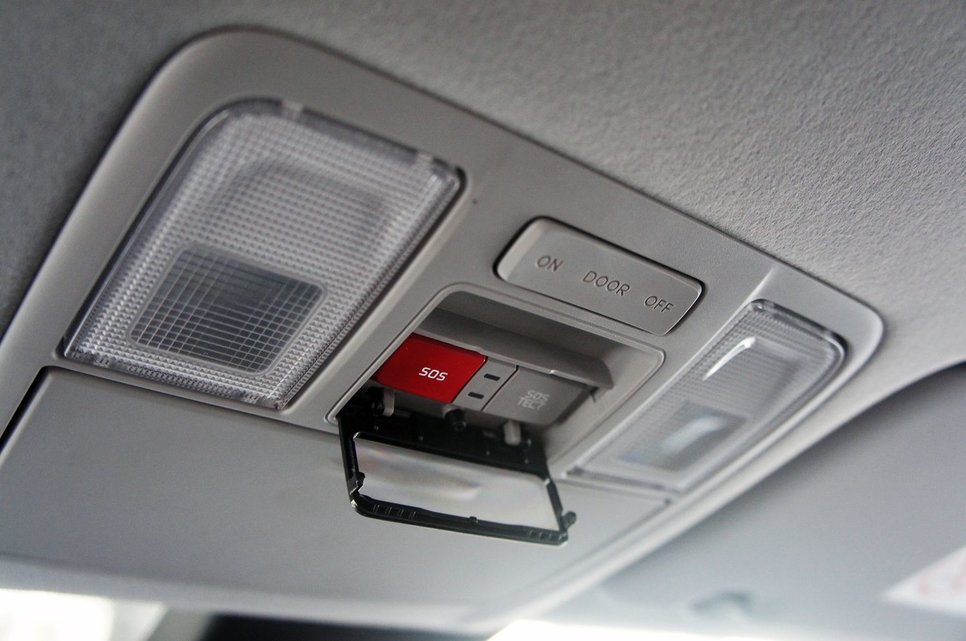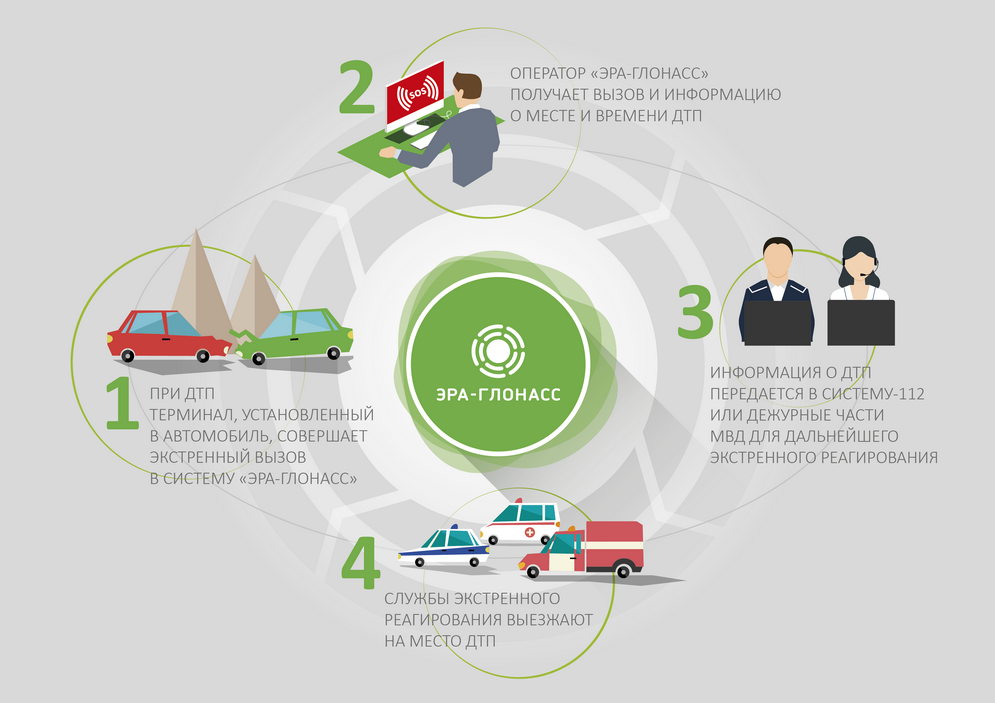Transmission of emergency data in the ERA-GLONASS system
All cars produced or imported into the territory of the Russian Federation from January 1, 2017 must be equipped with ERA-GLONASS modules. New Lada cars have been equipped with emergency SOS buttons since 2016. The GOST on emergency response system in case of accidents appeared back in 2011, but so far no technical article has been written describing the principles of its operation. So who cares, please.


ERA-GLONASS is the Russian State Emergency Response System for Accidents, aimed at improving road safety and reducing road traffic fatalities by reducing the alert time for emergency services. In essence, this is a partially copied eCall European system with some differences in the transmitted data and partially backward compatible with the European parent. The principle of operation of the system is quite simple and logical: in case of an accident, the module built into the car (IVS) in a fully automatic mode and without human intervention determines the severity of the accident, determines the location of the vehicle via GLONASS or GPS, communicates with the ERA-GLONASS infrastructure and in accordance with the protocol, transmits the necessary data on the accident (some kind of distress signal). Having received a distress call, an employee of the call center of the ERA-GLONASS operator should call the on-board device and find out what happened. If no one answers, transfer the received data to Sistema-112 and send to the exact coordinates of the rescue team and the medical team, moreover, the last one to arrive at the place is given 20 minutes. And all this, I repeat, without human intervention: even if people involved in an accident cannot independently call emergency services, accident data will still be transmitted.
The infrastructure for the system can be divided into 3 main parts:
1. Emergency call devices installed in vehicles (according to the eCall standard, these devices are called IVS - In Vehicle System) and which collect and transmit data from the Vehicle
2. Mobile infrastructure, in fact, a single virtual mobile operator (MVNO), based not on one, but on all real mobile operators. Thus, in the case of an emergency call, it is sufficient to have coverage of any of the mobile operators operating in the Russian Federation, which in turn significantly increases the coverage area of the system. Also, in order to ensure maximum coverage, conventional GSM was chosen as the reference technology for data transmission.
3. Calls reception and processing infrastructure (by eCall - PSAP - Public Safety Answering Point), which is a large call center for receiving and processing calls.
, « » «» - eCall: .
, ( GPRS ) , , (). , GSM , DialUp 2000-, , ARQ.
IVS (Uplink — Figure 1) PSAP (Downlink — Figure 2) ( ):

3- :
1. (Figure 1 — )
2. ( Figure 1 StartMSD Figure 2)
3. ' ( Figure 1, 3- ( , , 3 — , — ). , .
, ETSI TS 126.267.
PSAP .1 :
ASN.1 « » :
, , , .
, - eCall. :
ERAGlonassAdditionalData:
, , : «-» , , , .. , «-», - — Connected Car.
, , - , , , , . !

What is an ERA?

ERA-GLONASS is the Russian State Emergency Response System for Accidents, aimed at improving road safety and reducing road traffic fatalities by reducing the alert time for emergency services. In essence, this is a partially copied eCall European system with some differences in the transmitted data and partially backward compatible with the European parent. The principle of operation of the system is quite simple and logical: in case of an accident, the module built into the car (IVS) in a fully automatic mode and without human intervention determines the severity of the accident, determines the location of the vehicle via GLONASS or GPS, communicates with the ERA-GLONASS infrastructure and in accordance with the protocol, transmits the necessary data on the accident (some kind of distress signal). Having received a distress call, an employee of the call center of the ERA-GLONASS operator should call the on-board device and find out what happened. If no one answers, transfer the received data to Sistema-112 and send to the exact coordinates of the rescue team and the medical team, moreover, the last one to arrive at the place is given 20 minutes. And all this, I repeat, without human intervention: even if people involved in an accident cannot independently call emergency services, accident data will still be transmitted.
What is an ERA infrastructure?
The infrastructure for the system can be divided into 3 main parts:
1. Emergency call devices installed in vehicles (according to the eCall standard, these devices are called IVS - In Vehicle System) and which collect and transmit data from the Vehicle
2. Mobile infrastructure, in fact, a single virtual mobile operator (MVNO), based not on one, but on all real mobile operators. Thus, in the case of an emergency call, it is sufficient to have coverage of any of the mobile operators operating in the Russian Federation, which in turn significantly increases the coverage area of the system. Also, in order to ensure maximum coverage, conventional GSM was chosen as the reference technology for data transmission.
3. Calls reception and processing infrastructure (by eCall - PSAP - Public Safety Answering Point), which is a large call center for receiving and processing calls.
How it works?
, « » «» - eCall: .
, ( GPRS ) , , (). , GSM , DialUp 2000-, , ARQ.
IVS (Uplink — Figure 1) PSAP (Downlink — Figure 2) ( ):

3- :
1. (Figure 1 — )
2. ( Figure 1 StartMSD Figure 2)
3. ' ( Figure 1, 3- ( , , 3 — , — ). , .
, ETSI TS 126.267.
PSAP .1 :
01580D0010410410410410410410410414100000000FFFFFFFFFFFFFFFFFF8020080200030104012328E
E6400400000000000000000000000000000000000000000000000000000000000000000000000000000000000000
00000000000000000000002000000080000000000000080000000000000004000800000000000000000000000000
000000000000
ASN.1 « » :
<ECallMessage> <id>1</id> <msd> <msdStructure> <messageIdentifier>3</messageIdentifier> <control> <automaticActivation> <false/> </automaticActivation> <testCall> <true/> </testCall> <positionCanBeTrusted> <false/> </positionCanBeTrusted> <vehicleType> <passengerVehicleClassM1/> </vehicleType> </control> <vehicleIdentificationNumber> <isowmi>111</isowmi> <isovds>111111</isovds> <isovisModelyear>1</isovisModelyear> <isovisSeqPlant>1111111</isovisSeqPlant> </vehicleIdentificationNumber> <vehiclePropulsionStorageType> <gasolineTankPresent> <true/> </gasolineTankPresent> </vehiclePropulsionStorageType> <timestamp>0</timestamp> <vehicleLocation> <positionLatitude>2147483647</positionLatitude> <positionLongitude>2147483647</positionLongitude> </vehicleLocation> <vehicleDirection>255</vehicleDirection> <recentVehicleLocationN1> <latitudeDelta>0</latitudeDelta> <longitudeDelta>0</longitudeDelta> </recentVehicleLocationN1> <recentVehicleLocationN2> <latitudeDelta>0</latitudeDelta> <longitudeDelta>0</longitudeDelta> </recentVehicleLocationN2> </msdStructure> <optionalAdditionalData> <oid>1.4.1</oid> <data>28EE640040000000000000000000000000000000000000000000000000000000000000</data> </optionalAdditionalData> </msd> </ECallMessage> <ERAAdditionalData> <diagnosticResult> <micConnectionFailure> <false/> </micConnectionFailure> <speakersFailure> <false/> </speakersFailure> <ignitionLineFailure> <false/> </ignitionLineFailure> <uimFailure> <false/> </uimFailure> <batteryFailure> <false/> </batteryFailure> <batteryVoltageLow> <false/> </batteryVoltageLow> <crashSensorFailure> <false/> </crashSensorFailure> <gnssReceiverFailure> <false/> </gnssReceiverFailure> <raimProblem> <true/> </raimProblem> <eventsMemoryOverflow> <false/> </eventsMemoryOverflow> </diagnosticResult> </ERAAdditionalData>
, , , .
, - eCall. :
- VIN
- (, , , ...)
- (, , ..)
- ( )
- ,
- , ...
ERAGlonassAdditionalData:
- ( , IVS)
- (, , , )
, , : «-» , , , .. , «-», - — Connected Car.
, , - , , , , . !
All Articles